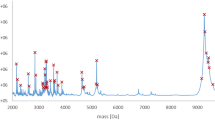Abstract
The geographical origin of commercial red ginseng concentrates was studied using LC-MS/MS and electronic nose analysis based on mass spectrometry. For LC-MS/MS, the Ra1, Rb1, Rg2 ginsenosides showed large differences between Korean and Chinese varieties. Rh2 and F2 were found only in Chinese red ginseng concentrate. Ion fragments were obtained using an electronic nose. Discriminant function analysis of fragment patterns allowed grouping into Korean, Chinese, and suspect origin concentrates. The mixing ratios of suspect origin specimens were predicted based on analysis of different mixing ratios of known specimens of Korean and Chinese origin. LC-MS/MS and electronic nose analysis together allowed method advantages and disadvantages to complement and compensate.
Similar content being viewed by others
References
Block KI, Mead MN. Immune system effects of echinacea, ginseng, and astragalus: A review. Integr. Cancer Ther. 2: 247–267 (2003)
Kwon BM, Kim MK, Baek NI, Kim DS, Park JD, Kim YK, Lee HK, Kim SI. Acyl-COA: Cholesterol acyltransferase inhibitory activity of ginseng sapogenins, produced from the ginseng saponins. Bioorg. Med. Chem. Lett. 9: 1375–1378 (1999)
Attele AS, Zhou YP, Xie JT, Wu JA, Zhang L, Dey L, Pugh W, Rue PA, Polonsky KS, Yuan CS. Antidiabetic effects of Panax ginseng berry extract and the identification of an effective component. Diabetes 51: 1851–1858 (2002)
Choi KT. Botanical characteristics, pharmacological effects and medicinal components of Korean Panax ginseng C A Meyer. Acta Pharm. Sinic. 29: 1109–1118 (2008)
Korea Ginseng & Tobacco Research Institute Korean Ginseng. Chunil Press. Daejon. Korea. pp. 98–110 (1994)
Sung KK. Analysis of ginsenosides of white and red ginseng concentrates. Korean J. Food Sci. Technol. 35: 536–539 (2003)
Kim KH, Dong HM, Han HJ, Lee YH, Moon JY, Bang KH, Noh BS. Analysis of geographical origin of red ginseng extract using mass spectrometer-based electronic nose. Korean J. Food Sci. Technol. 45: 652–656 (2013)
Cho IH, Lee HJ, Kim YS. Difference in the volatile compositions of ginseng species. J. Agr. Food Chem. 60: 7616–7622 (2012)
Jeong MS, Lee SB. Discrimination of geographical origin for herbal medicine by mineral content analysis with energy dispersive X-Ray fluorescence spectrometer. Korean J. Food Sci. Technol. 40: 135–140 (2008)
Chan TWD, But PPH, Cheng SW, Kwon IMY, Lau FW, Xu HX. Differentiation and authentication of Panax ginseng, Panax quinquefolius, and ginseng products by using HPLC/MS. Anal. Chem. 72: 1281–1287 (2000)
Son HJ, Kang JH, Hong EJ, Lim CL, Choi JY, Noh BS. Authentication of sesame oil with addition of perilla oil using electronic nose based on mass spectrometry. Korean J. Food Sci. Technol. 41: 609–614 (2009)
Choi JY, Bang KH, Han KY, Noh BS. Discrimination analysis of the geographical origin of food. Korean J. Food Sci. Technol. 44: 503–525 (2012)
Song HJ. A comparative study on characteristic of Ginseng radix in Korea and China. Korean. J. Herbology 25: 61–64 (2010)
Jeon YJ. Development for discrimination technology of red ginseng concentrate original. MS thesis, Joongbu University, Chungnam, Korea (2011)
Chen J, Korfmacher WA, Hsieh Y. Chiral liquid chromatographytandem mass spectrometric methods for stereoisomeric pharmaceutical determinations. J. Chromatogr. B 820: 1–8 (2005)
Liu Y, Yang J, Cai Z. Chemical investigation on Sijunzi decoction and its two major herbs Panax ginseng and Glycyrrhiza uralensis by LC/MS/MS. J. Pharmaceut. Biomed. 41: 1642–1647 (2006)
Smart Nose. SMart Nose: User’s manual. Marin-Epagnier, Switzerland. pp. 98–99 (2008)
Noh BS, Ko JW, Kim SY. Use of conducting polymer sensor and metal oxide sensor of electronic nose on discrimination of the habitat for Ginseng. J. Nat. Sci. Inst. Seoul Women’s Univ. 9: 81–84 (1997)
Park MH, Jeong MK, Yeo JD, Son HJ, Lim CL, Hong EJ, Noh BS, Lee JH. Application of solid phase-microextraction [SPME] and electronic nose techniques to differentiate volatiles of sesame oils prepared with diverse roasting conditions. J. Food Sci. 76: 80–88 (2011)
Cozzolino D, Smyth HE, Cynkar W, Dambergs RG, Gishen M. Usefulness of chemometrics and mass spectrometry-based electronic nose to classify Australian white wines by their varietal origin. Talanta 68: 382–387 (2005)
Hong EJ, Park SJ, Choi JY, Noh BS. Discrimination of palm olein oil and palm stearin oil mixtures using a mass spectrometry-based electronic nose, Food Sci. Biotechnol. 20: 809–816 (2011)
Author information
Authors and Affiliations
Corresponding author
Rights and permissions
About this article
Cite this article
Moon, J.Y., Han, H.J., Park, S.W. et al. Discrimination of the origin of commercial red ginseng concentrates using LC-MS/MS and electronic nose analysis based on a mass spectrometer. Food Sci Biotechnol 23, 1433–1440 (2014). https://doi.org/10.1007/s10068-014-0196-z
Received:
Revised:
Accepted:
Published:
Issue Date:
DOI: https://doi.org/10.1007/s10068-014-0196-z




